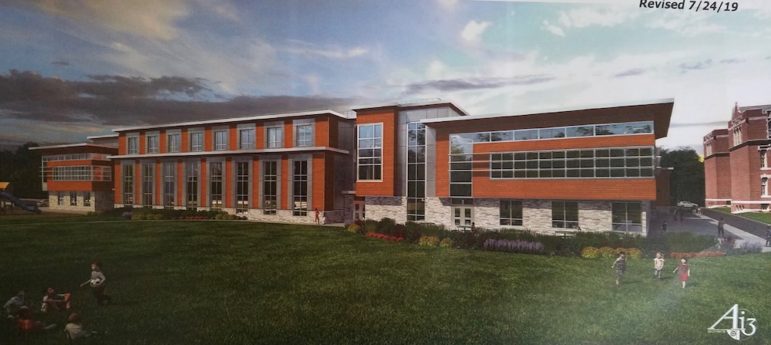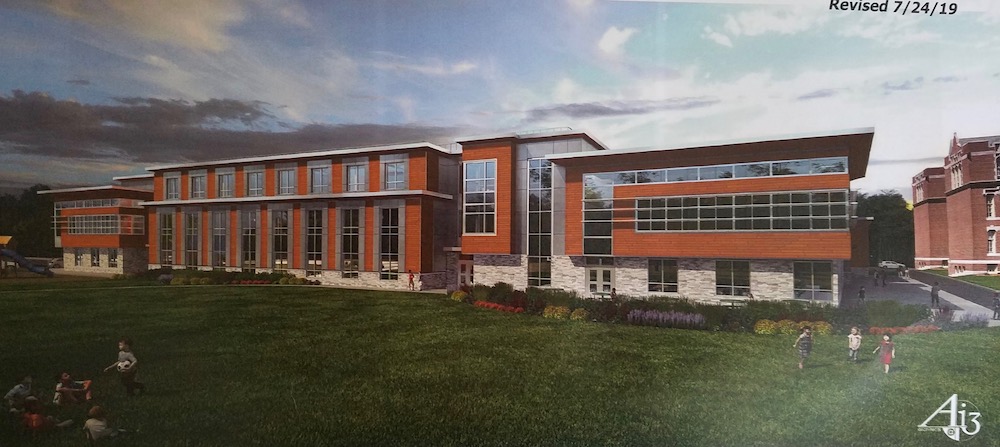
Members of the School Building Committee worry about controlling the costs in Watertown’s three elementary school building projects in a climate with a competitive construction industry and international tariff wars.
The projects include brand new schools at Hosmer and Cunniff elementary schools and a major renovation and addition at Lowell Elementary School. At least one member was bothered that Watertown may have missed an opportunity to keep the projects on budget using an alternative to the typical construction model.
The design firm, Ai3 Architects, have nearly completed the design development phase (the second of three major phases before construction) and the costs are currently being estimated.
School Building Committee member Kelly Kurlbaum, who has a professional architect and owner’s project manager (OPM) background, said she worries about the cost rising beyond the estimates. She worries about issues like the tariff wars between the U.S. and places like China, which provide construction materials, driving up prices.
“Sheet metal costs are through the roof,” Kurlbaum said. “Are we aware of that?”
Director of Public Buildings Lori Kabel, who sits on the committee, said she is very concerned about the cost rising through unanticipated change orders to the original design.
The current designs for the three elementary schools have been sent to two independent cost estimators, said Vivian Varbedian, senior project manager from Hill International, Watertown’s OPM. She said the firms being used are among the best, noting that the cost estimator used by Ai3 — PM&C — is the one she usually uses, so she went with RLB, another reputable firm.
By getting good cost estimates, including looking for areas in the designs that are not fully flushed out, the cost estimates will be accurate, Varbedian said.
“We have reputable firms doing the cost estimates,” Varbedian said. “Year after year we have projects that come in within fractions of a percent of the cost estimate.”
Scott Dunlap of Ai3 added that this is the time, before final construction documents are created, when the project will be adjusted, so surprises don’t come up during construction.
“If we see it is over, an increase in cost, it is not over budget,” Dunlap said. “We have got to determine how to get back on budget (before final designs are approved).”
Dunlap hoped to get the first cost estimates by the end of August.
The project will also carry a contingency fund of five percent of the total budget for things like change orders, Varbedian said. That money will be for change orders that come from the general contractor, but others may come from the School Building Committee. Another one percent for change orders proposed by the owners (the school district) will be added, Varbedian said.
Kabel suggested that the School Building Committee come up with a process to evaluate and approve or disapprove change orders.
Selection of Construction Model
Wednesday night, the School Building Committee decided to use the traditional method of hiring a general contractor to oversee the building projects at Watertown’s three elementary schools, forgoing a newer alternative that would cap the cost of the project.
The committee overseeing the projects has discussed which method to use — Design-Bid-Build or Construction Manager at Risk — numerous times, but did not make the decision until Wednesday night.
The Design-Bid-Build option (called Chapter 149 by the state), which uses a general contractor has a lump sum bid amount for the project which can be increased through change orders approved by the owner. The method has several advantages, Varbedian said, including:
- increasing bidding competition which often results in lower construction costs
- design and documentation is 100 percent complete before construction contracts are awarded
- the construction cost is known and fixed at the time of construction award
- it gives the owner and OPM greater control of design and construction
The Construction Manager at Risk (called Chapter 149A) is a newer options that provides and alternative method for communities to use on public projects which includes a guaranteed maximum price. Some of the advantages are:
- the ability to interview and select an contractor independent of cost
- the construction manager is involved in the design process and can make recommendations on schedule, logistics, phasing costs and more
- the working relationship with construction manager starts before construction begins
- the ability to begin construction before the design is 100 percent complete and before the guaranteed maximum price is finalized
The first discussion of Design-Bid-Build vs. Construction Manager at Risk came in late 2018, and the committee discussed it a number of other times, but the final decision was not made until Wednesday.
Superintendent Dede Galdston said that she believed that it was too late to use many of the advantages of the Construction Manager at Risk method.
“We are halfway through what they would do,” Galdston said.
Varbedian added that if Watertown was to choose this method, there would be an approval process of by the state Department of the Inspector General of up to 60 days, plus 30 days to request bids and another couple weeks to review the bids and award the contract. The delay of more than three months also dissuaded Gladston.
Kurlbaum said she was disappointed that the decision took too long.
“Shame on us. We have been talking about this since December 2018,” Kurlbaum said. “This should have been voted day 1 (during Schematic Design), but we are making the decision after Design Development.”
Town Council Vice President Vincent Piccirilli said that the project is a lot simpler than it was when the committee first discussed the options. Originally, the plan was to do significant renovations of all three schools and make some small additions. Now there are two new schools, which removes many of the potential unforeseen costs of a renovation, he said.
Kurlbaum said even at this point the Construction Manager at Risk option could provide benefits, because the plan calls for moving whole schools to the old Hosmer during the construction at Lowell and Cunniff, and operate the Hosmer at the same time. She sees potential problems with children playing outside next to a construction site, conflicts with neighbors and traffic.
Paul Anastasi, a former school facilities manager in Watertown and Newton, said that he worries about cost escalation from either Design-Bid-Build or Construction Manager at Risk.
“I have some experience with both processes,” Anastasi said. “They are two different ways for contractors to make money.”
The committee ultimately voted 7-0 to choose the Design-Bid-Build method.
